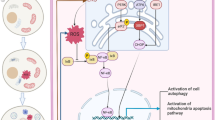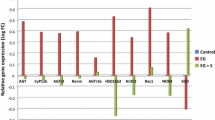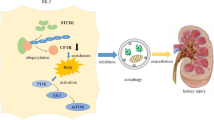Abstract
The aim of this study is to clarify the effect of oxidative stress on monosodium urate (MSU)-mediated apoptosis of renal cells. Quantitative real-time polymerase chain reaction and immunoblotting for Bcl-2, caspase-9, caspase-3, iNOS, cyclooxygenase-2 (COX-2), interleukin-1β (IL-1β), IL-18, TNF receptor-associated factor-6 (TRAF-6), and mitogen-activated protein kinases were performed on human embryonic kidney 293 (HEK293) cells, which were stimulated by MSU crystals. Fluorescence-activated cell sorting was performed using annexin V for assessment of apoptosis. Reactive oxygen species (ROS) were measured. IL-1β siRNA was used for blocking IL-1β expression. MSU crystals promoted ROS, iNOS, and COX-2 expression and also increased TRAF-6 and IL-1β expression in HEK293 cells, which was inhibited by an antioxidant ascorbic acid. Caspase-dependent renal cell apoptosis was induced through attenuation of Bcl-2 and enhanced caspase-3 and caspase-9 expression by MSU crystals, which was significantly reversed by ascorbic acid and transfection of IL-1β siRNA to HEK293 cells. Ascorbic acid inhibited phosphorylation of extracellular signal-regulated kinase and Jun N-terminal protein kinase stimulated by MSU crystals. ROS accumulation and iNOS and COX-2 mRNA expression by MSU crystals was also suppressed by transfection with IL-1β siRNA. Oxidative stress generated by MSU crystals promotes renal apoptosis through the mitochondrial caspase-dependent apoptosis pathway.






Similar content being viewed by others
References
Talbott JH, Terplan KL (1960) The kidney in gout. Medicine (Baltimore) 39:405–467
Nickeleit V, Mihatsch MJ (1997) Uric acid nephropathy and end-stage renal disease-review of a non-disease. Nephrol Dial Transplant 12:1832–1838
Mazzali M, Kanellis J, Han L, Feng L, Xia YY, Chen Q, Kang DH, Gordon KL, Watanabe S, Nakagawa T, Lan HY, Johnson RJ (2002) Hyperuricemia induces a primary renal arteriolopathy in rats by a blood pressure-independent mechanism. Am J Physiol Renal Physiol 282:F991–F997
Emmerson BT, Cross M, Osborne JM, Axelsen RA (1990) Reaction of MDCK cells to crystals of monosodium urate monohydrate crystals and uric acid. Kidney Int 37:36–43
Umekawa T, Chegini N, Khan SR (2003) Increased expression of monocyte chemoattractant protein-1 (MCP-1) by renal epithelial cells in culture on exposure to calcium oxalate, phosphate and uric acid crystals. Nephrol Dial Transplant 18:664–669
Lhotta K, Gruber J, Sgonc R, Fend F, Konig P (1998) Apoptosis of tubular epithelial cells in familial juvenile gouty nephropathy. Nephron 79:340–344
Huang WC, Hsu CY, Hu HH, Chou KJ, Lee PT, Chen CL, Chang TY, Fang HC, Chen CL (2008) Lack of direct apoptotic effect of uric acid on renal epithelial cells. Acta Nephrologica 22:91–96
Martinon F, Petrilli V, Mayor A, Tardivel A, Tschopp J (2006) Gout-associated uric acid crystals activate the NALP3 inflammasome. Nature 440:237–241
Martinon F (2010) Mechanisms of uric acid crystal-mediated autoinflammation. Immunol Rev 233:218–232
Martinon F, Burns K, Tschopp J (2002) The inflammasome: a molecular platform triggering activation of inflammatory caspases and processing of proIL-β. Mol Cell 10:417–426
Zhou R, Yazdi AS, Menu P, Tschopp J (2011) A role for mitochondria in NLRP3 inflammasome activation. Nature 469:221–225
Haddad JJ (2004) Redox and oxidant-mediated regulation of apoptosis signaling pathways: immuno-pharmaco-redox conception of oxidative siege versus cell death commitment. Int Immunopharmacol 4:475–493
Choe JY, Jung HY, Park KY, Kim SK (2014) Enhanced p62 expression through impaired proteasomal degradation is involved in caspase-1 activation in monosodium urate crystal-induced interleukin-1β expression. Rheumatology (Oxford) 53:1043–1053
Iseki K, Ikemiya Y, Inoue T, Iseki C, Kinjo K, Takishita S (2004) Significance of hyperuricemia as a risk factor for developing ESRD in a screened cohort. Am J Kidney Dis 44:642–650
Brochner-Mortensen K (1941) 100 gouty patients. Acta Media Scand 106:81–107
Park SJ, Jeong KS (2004) Cell-type-specific activation of mitogen-activated protein kinases in PAN-induced progressive renal disease in rats. Biochem Biophys Res Commun 323:1–8
Peng Y, Kwok KH, Yang PH, Ng SS, Liu J, Wong OG, He ML, Kung HF, Lin MC (2005) Ascorbic acid inhibits ROS production, NF-kappa B activation and prevents ethanol-induced growth retardation and microencephaly. Neuropharmacology 48:426–434
Schultz DR, Harrington WJ Jr (2003) Apoptosis: programmed cell death at a molecular level. Semin Arthritis Rheum 32:345–369
Malemud CJ, Sun Y, Pearlman E, Ginley NM, Awadallah A, Wisler BA, Dennis JE (2012) Monosodium urate and tumor necrosis factor-α increase apoptosis in human chondrocyte cultures. Rheumatology (Sunnyvale) 2:113
Bordoni V, De Cal M, Rassu M, Cazzavillan S, Segala C, Bonello M, Ranishta R, Andrikos E, Yavuz A, Salvatori G, Galloni E, Bolgan I, Bellomo R, Levin N, Ronco C (2005) Protective effect of urate oxidase on uric acid induced-monocyte apoptosis. Curr Drug Discov Technol 2:29–36
Yu MA, Sánchez-Lozada LG, Johnson RJ, Kang DH (2010) Oxidative stress with an activation of the renin-angiotensin system in human vascular endothelial cells as a novel mechanism of uric acid-induced endothelial dysfunction. J Hypertens 28:1234–1242
Akahoshi T, Nagaoka T, Namai R, Sekiyama N, Kondo H (1997) Prevention of neutrophil apoptosis by monosodium urate crystals. Rheumatol Int 16:231–235
Tudan C, Fong D, Duronio V, Burt HM, Jackson JK (2000) The inhibition of spontaneous and tumor necrosis factor-alpha induced neutrophil apoptosis by crystals of calcium pyrophosphate dihydrate and monosodium urate monohydrate. J Rheumatol 27:2463–2472
Han HJ, Lim MJ, Lee YJ, Lee JH, Yang IS, Taub M (2007) Uric acid inhibits renal proximal tubule cell proliferation via at least two signaling pathways involving PKC, MAPK, cPLA2, and NF-κB. Am J Physiol Renal Physiol 292:F373–F381
Schelling JR, Cleveland RP (1999) Involvement of Fas-dependent apoptosis in renal tubular epithelial cell deletion in chronic renal failure. Kidney Int 56:1313–1316
Park CH, Noh JS, Okamoto T, Park JC, Yokozawa T (2012) Evaluation of Effects of Chinese prescription Kangen-karyu on diabetes-induced alterations such as oxidative stress and apoptosis in the liver of type 2 diabetic db/db mice. Evid Based Complement Altern Med 2012:143489
Vane JR, Mitchell JA, Appleton I, Tomlinson A, Bishop-Bailey D, Croxtall J, Willoughby DA (1994) Inducible isoforms of cyclooxygenase and nitric-oxide synthase in inflammation. Proc Natl Acad Sci 91:2046–2050
Simon HU, Haj-Yehia A, Levi-Schaffer F (2000) Role of reactive oxygen species (ROS) in apoptosis induction. Apoptosis 5:415–418
Kuwano K, Hara N (2000) Signal transduction pathways of apoptosis and inflammation induced by the tumor necrosis factor receptor family. Am J Respir Cell Mol Biol 22:147–149
Xia Z, Dickens M, Raingeaud J, Davis RJ, Greenberg ME (1995) Opposing effects of ERK and JNK-p38 MAP kinases on apoptosis. Science 270:1326–1331
Acknowledgments
This work was supported by a grant from the Research Institute of Medical Science, Catholic University of Daegu (2013).
Conflict of interest
The authors do not have an actual or potential conflict of interest or not get interest of any kind to declare with regard to this work.
Author information
Authors and Affiliations
Corresponding author
Electronic supplementary material
Below is the link to the electronic supplementary material.
Rights and permissions
About this article
Cite this article
Choe, JY., Park, KY. & Kim, SK. Oxidative stress by monosodium urate crystals promotes renal cell apoptosis through mitochondrial caspase-dependent pathway in human embryonic kidney 293 cells: mechanism for urate-induced nephropathy. Apoptosis 20, 38–49 (2015). https://doi.org/10.1007/s10495-014-1057-1
Published:
Issue Date:
DOI: https://doi.org/10.1007/s10495-014-1057-1




